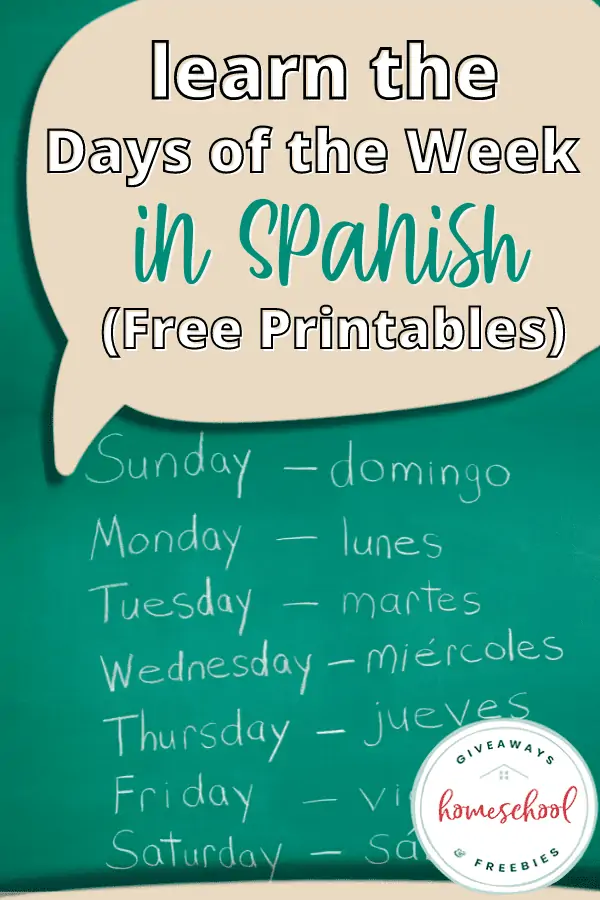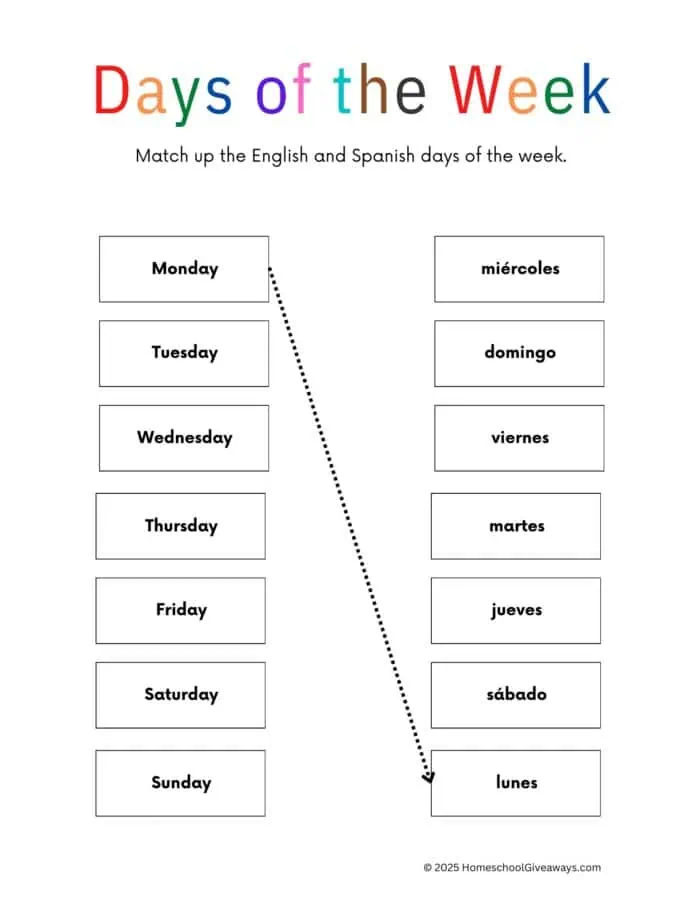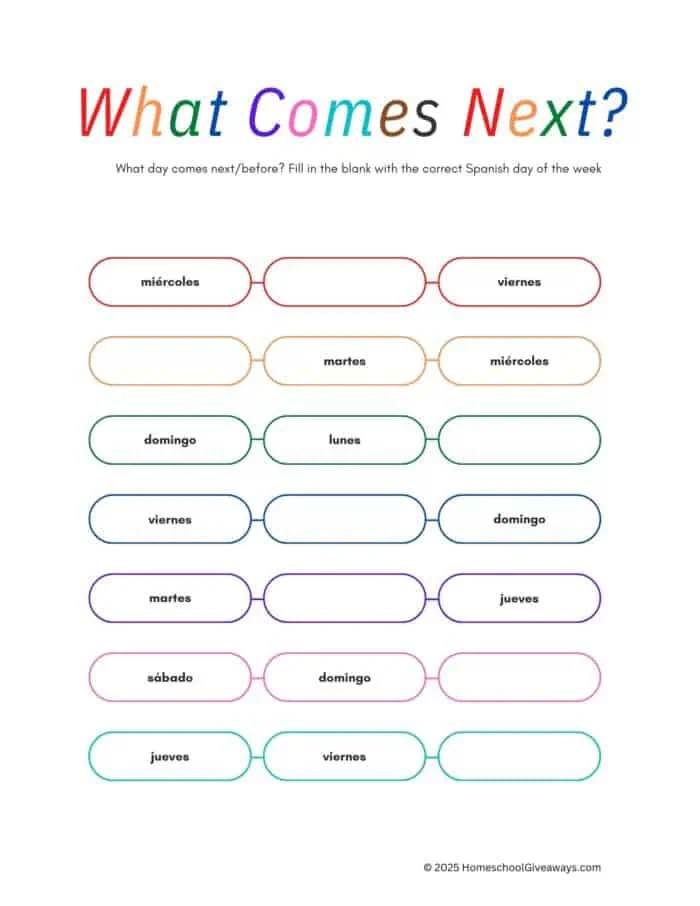11 Easy Days of the Week in Spanish Worksheets for Kids
Published:
March 21, 2022
Contributor:
Jeannette Tuionetoa
Disclosure: This post may contain affiliate links, meaning if you decide to make a purchase via my links, I may earn a commission at no additional cost to you. See my disclosure for more info.
There are easy ways to learn the Spanish days of the week in your homeschool and is an important first step for beginner Spanish learners. Check out this list of the days of the week in Spanish, their pronunciations and so much more below.

What are the Days of the Week in Spanish?
Here are the days of the week in Spanish and in English as a quick reference:
|
Spanish |
English |
|---|---|
|
lunes |
Monday |
|
martes |
Tuesday |
|
miércoles |
Wednesday |
|
jueves |
Thursday |
|
viernes |
Friday |
|
sábado |
Saturday |
|
domingo |
Sunday |
Where do the Names of the Spanish Week Days Come From?
When teaching your children the English days of the week and Spanish days of the week, you may benefit from understanding where the words are derived from. Here are some brief tidbits about where the words came from.
Monday (lunes)
- The day Monday in Spanish is lunes, which comes from the word luna. Luna means moon. The word Monday stems from the word moon in English, Japanese, German, and other different romance languages. So, in essence, it’s really moon day.
Tuesday (martes)
- It is interesting that many days of the week are named after gods of Roman mythology. Tuesday’s Spanish translation is martes, which comes from the word dies Martis or Mars. Mars is the Roman god of war. In English, Tuesday comes from the Norse God, Tyr, who was also a god of war. Basically, Tuesday is translated as the god of war’s day.
Wednesday (miércoles)
- The Spanish word miércoles is named after Mercury, the Roman god of financial gain and trickery. El miércoles, can also be known as a midweek or la entresemana.
Thursday (jueves)
- Thursday is considered Jupiter’s day (jueves) in Spanish. In English, Thursday is Thor’s day. Both, Jupiter and Thor, are the gods of thunder in mythology.
Friday (viernes)
- If you haven’t guessed it by now, viernes (Friday in Spanish) is derived from Venus, the Roman goddess of love, beauty, and prosperity. (Who doesn’t love Fridays? And isn’t Friday usually “payday” for many working folks?
Saturday (sábado)
- Saturday in English is derived from the Roman god, Saturn. However, Saturday in Spanish isn’t named after a god of mythology but named after the Sabbath (sábado), a day of rest.
Sunday (domingo)
- The Latin root word for Sunday in Spanish (domingo) is Domenica. Domenica means the day of the Lord. Both Sunday and Saturday (sábado y domingo) are tied to biblical root meanings. Thank God for weekends!
How do you say the Days of the Week in Spanish?
Here is an easy pronunciation guide for the días de la semana (days of the week) in Spanish:
|
Day of Week |
Pronounced |
|---|---|
|
lunes (Monday) |
loo-nes |
|
martes (Tuesday) |
mar-tes |
|
miércoles (Wednesday) |
mee-air-coh-les |
|
jueves (Thursday) |
hway-bes |
|
viernes (Friday) |
bee-air-nes |
|
sábado (Saturday) |
sah-bah-doh |
|
domingo (Sunday) |
doh-ming-oh |
What are the Abbreviations for Days of the Week in Spanish?
There are a few different options that can be used as abbreviations – a shortening of the word, a 2 letter code and a single letter code. The single letter code is always the first letter of the word EXCEPT for miércoles. The letter X is used instead to avoid confusion with martes as they both begin with the letter M.
|
Day of the Week |
Abbreviation |
2 Letter |
Single Letter |
|---|---|---|---|
|
lunes (Monday) |
lun. |
lu |
L |
|
martes (Tuesday) |
mart. |
ma |
M |
|
miércoles (Wednesday) |
miérc. |
mi |
X |
|
jueves (Thursday) |
juev. |
ju |
J |
|
viernes (Friday) |
vier. |
vi |
V |
|
sábado (Saturday) |
sáb. |
sa/sá |
S |
|
domingo (Sunday) |
dom. |
do |
D |
Are Days of the Week Capitalized in Spanish?
In English we start the days of the week with a capital letter. But in Spanish, the days of the week are not capitalized but are written in lower case. (Unless it is at the beginning of a sentence / first word of a sentence, of course.)
Are Days of the Week Masculine or Feminine in Spanish?
Spanish words, in general, are classified as either masculine nouns or feminine in gender. It is just the class that Spanish words are said, some words you refer to in a gendered article los or definite article el.
The words in the days of the week are all said as masculine in gender, so you would say:
- el lunes
- el martes
- el miércoles
- el jueves
- el viernes
- el sábado
- el domingo
Are there any other Differences in Days of the Week from English to Spanish?
Yes, there are a couple more important differences to note between Spanish days of the week compared to the days of the week in English.
Plural Form of the Days of the Week
- The plural form of the week days always remains the same spelling, so there is not another “s” added to the day.
- For singular form, like “on Monday” it is said el lunes.
- For plural form, like “on Mondays” it is said los lunes. Los makes the day plural and el makes the day singular, not an additional “s.”
- Exception: Saturday and Sunday are also the only days of the week that do not end in “s” which means to make it plural you do an “s” to the end of the word. (i.e. los domingos, los sabados)
- Saturday and Sunday are considered the weekend on the Spanish calendar, therefore are known in Spanish as “el fin de semana” so the end of the week.
First Day and Last Day of the Week Differences
- English speaking countries normally begin the days of the week with Sunday. However, Spanish speaking countries consider Monday as the first day of the week.
- Therefore, Sunday is actually the last day of the week in a Spanish calendar.
How to Teach the Days of the week in Spanish?
We’ve put together 6 ideas to help your elementary students learn their Spanish days.
1. Use a mnemonic to remember (L, M, M, J, V, S, D)
Acronyms are useful tools for students to use when trying to remember processes and rules in various subjects. The same is true in teaching your students the Spanish word for the days of the week.
Try something like “Last May, my jaguar visited South Dakota” as an example.
2. Sing a “days of the week” song
Singing songs is a fun and easy way for kids to reinforce what they have learned about the Spanish language days of the week. The songs are fun and get kids active and dancing.
3. Watch videos with a “days of the week” theme
There are loads of resources online for kids to hear the days of the week spoken out loud. Children can hear audio of how the words are pronounced. They can also watch people speak the words out loud to say the Spanish word for each specific day of the week. Here’s one example from YouTube by Jack Hartman:
4. Play “days of the week” Games
There are a slew of games to share with your kids for learning the days of the week’s Spanish names. From online interactive games to hands-on memory games, they will add lots of fun and excitement to your Spanish lessons.
5. Daily Immersion
It helps many families to label items around their homes with Spanish vocabulary like the day names of the week. Although you can’t label the days of the week, displaying a “days of the week” poster or cards on the wall of your homeschool area will assist your visual learners to remember them.
6. Use Worksheets for Review
Worksheets and printables are sometimes a great way to reinforce learning, especially when teaching the Spanish days of the week. To wrap up your lessons, grab our Spanish Days for the Week worksheets to help your student practice the days of the week at home in different ways.
Days of the Week in Spanish Worksheets

Spanish Days of the Week Match Worksheet
After learning the days of the week in Spanish, this match worksheet can be used for practice, review or as a quick assessment. Complete with an answer key

Fill-in-the-Blank Spanish Days Worksheet
Practice learning the Spanish weekdays with this fill-in-the blank worksheet. Complete with an answer key

Spanish Days of the Week Worksheet Pack
Grab our entire 11-page Spanish days of the week worksheet pack including the 2 worksheets above. It’s the perfect resource for introducing the days of the week vocabulary to your homeschoolers. It comes with a printable poster, handwriting activity, and a mini-book to color, trace, and assemble. There’s also a handwriting practice page!








